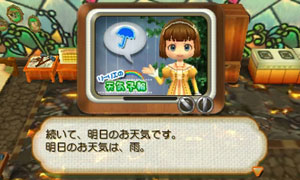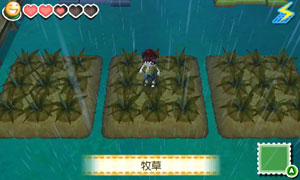Game Time
Story of Seasons is made up of four seasons per year with 31 days per season. The game's time is based on 1 real-time second to 1 in-game minutes, so 1 real-time minute is 1 in-game hour. The game's time will move forward from the time you wake up in the morning until the time you go to bed at night. You cannot stay up a full 24 hours, as the game will force you to go to bed at 5:59 am. The game's clock is displayed as a 24-hour clock, with 6 am being 6:00, noon being 12:00, 3pm is 15:00, and 6pm is 18:00. There is no in-game option that allows you to chage the 24-hour clock into a 12-hour AM/PM clock.
The game's time does not stop when you walk indoors, but you can pause the game by going into your rucksack, talking to a villager, or by pressing the Right Shoulder button to open the quick shortcut menu. Closing your 3DS will also pause the game until you come back to it.
The sunlight available in the game (i.e., day time) will change depending on the season. When you are in Spring, night time starts at 18:00, but during Summer, it doesn't become dark until 20:00. Winter time has an early evening at 17:00.
Seasonal Weather
There are five weather types: sun, rain, typhoon, snow, and blizzard. Each morning one of these weather types will take place and it will last all day. The icon in the upper-right corner on the top screen of your 3DS will indicate which weather you're experiencing.

You can learn what the weather will be by watching Lillie's weather report on your television. The TV does not come with your farm house, so you will need to construct it by using the construction bench, blueprint, and required materials. The blueprint for the television is for sale at Mistel's Antique Shop for 2500 G after you have upgraded your farm house to the Decent Farm House size, which only requires 15 Small Stones and 15 Lumber.
The materials you'll need are 12 Black Lumber, 6 Bottles, 5 Iron, 5 Glittering Stone, and 3 Crystal.
- Black Lumber comes from cutting Black Branches with your Axe. Early in the game, you can find Black Branches on the ground or when fishing after Otmar gives you the fishing pole (walk into his shop on or after Spring 28).
- Bottles can be found when diving or caught when fishing.
- Iron can also be found when diving or purchased from the Silk Country vendor for 1000 G each (700 G for Seeedling mode).
- Glittering Stone is found when diving in the river within the Riverside Pasture area, but it is pretty uncommon. It is sold at the Wheat Country vendor for 3700 G each (2590 G for Seedling mode), but not until Spring of year 2.
- Crystal can be purchased from Silk Country for 5000 G each (3500 G for Seedling), as it can't be caught when fishing or diving.
Black Branches, Iron, Glittering Stone, and Crystal are also available in the Safari Zone, but the area is only available after you unlock it starting in Fall of year 1.
The weather is pretty much set in advance, so you can't simply reload your save game to try and avoid a specific weather type. Festival days will always be sunny even if the weather report was predicting something different for that day.

Stormy weather is not kind to crops, animals, or your health! A typhoon or blizzard will reduce the Star Rank points of a crop by 5 points. Any crop that has very low Star Points (SP), such as pasture grass that typically only has 1 SP (.5 stars), can be destroyed by a bad weather storm. You can fix the damage to your crop by applying Fertilizer, although you can't fertilize pasture grass; you'll simply have to replant it if necessary.
Your farm animals should remain indoors during a bad weather storm (or even when it is raining, but snowing is okay to go outside). They can receive between +20 and +40 stress points if they're outside, and -5 to -20 friendship points. Pets will get a -2 FP hit if you take them outside during a storm.
A storm will also decrease your health by 10 points when you step out into it for the first time that day, but you can easily restore that by eating food. Using your tools will also use more stamina.
Storms will occur during Summer season (typhoons) and Winter season (blizzards). At most, you'll only experience four storms during those seasons. If you haven't experienced a storm by the 26th of the season, you will have one trigger on the 27th. Storms won't occur within three days of each other.